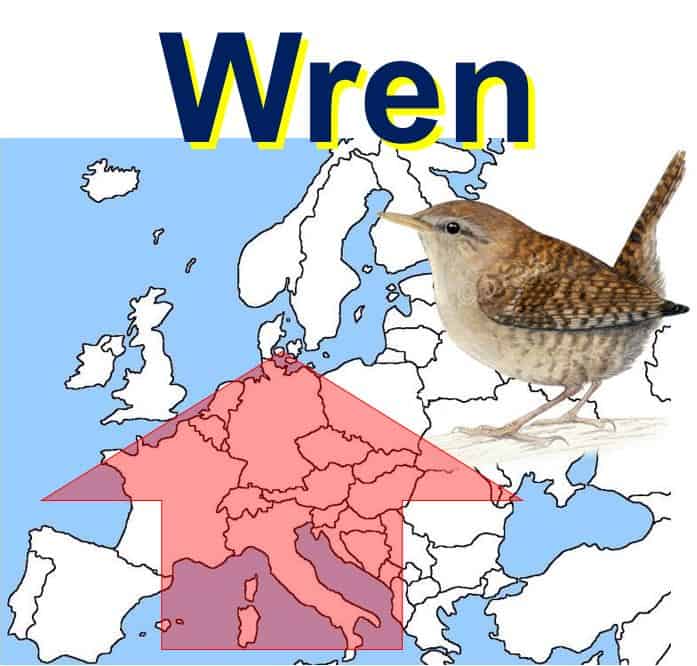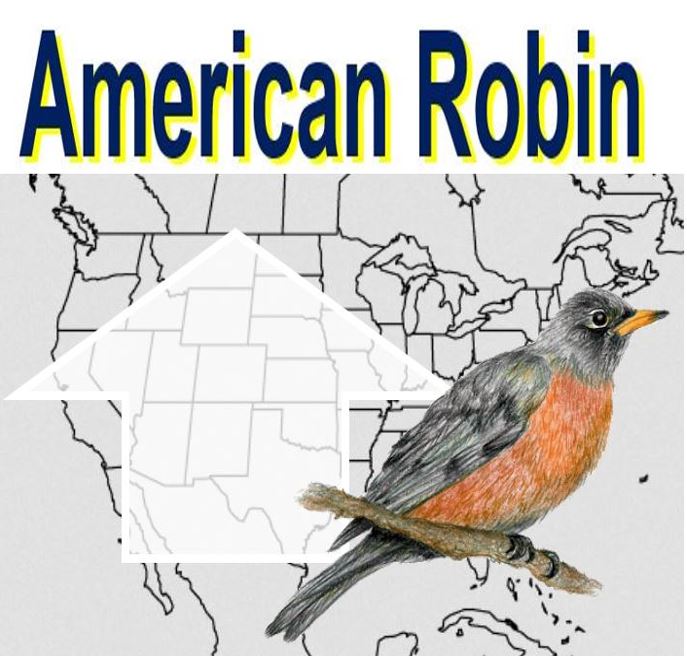Bird populations across Europe and North America are changing because of climate change, with some species experiencing increases while others decline, and many types of birds shifting their habitats northwards, says a team of scientists led by Durham University in England.
Researchers at the Department of Biological & Biomedical Sciences at Durham found that populations of bird species that had expected to do well because of climate change had significantly outperformed those predicted to do badly over a 3-decade period from 1980 to 2010.
The study, conducted in collaboration with the US Geological Survey (USGS) and the Royal Society for the Protection of Birds (RSPB), has been published in the journal Science (citation below).
 The Wren (Troglodytes troglodytes) is moving northwards. Global warming is making the summer’s in southern Europe hotter and drier, while winters in the north of the continent are becoming milder. The wren population is rising in the north and declining in the south.
The Wren (Troglodytes troglodytes) is moving northwards. Global warming is making the summer’s in southern Europe hotter and drier, while winters in the north of the continent are becoming milder. The wren population is rising in the north and declining in the south.
This study is the first one to clearly demonstrate that climate is having a large-scale and similar influence on common-bird distribution and abundance in widely separate parts of the world, the authors said.
Garden and woodland birds
Among the bird species showing pronounced effects of global warming are common garden and woodland birds, including the American robin in North America and the wren in Europe.
The researchers characterised the climates favoured by several different bird species to determine whether recent changes in climate should have negatively or positively affected common breeding birds.
Using climate records covering a 30-year period (1980-2010), they split the species into two groups based on whether climate had been getting progressively worse or better for each species.
Using information gathered from the same 30-year period for 380 common bird species in the USA and 145 in Europe, they contrasted the population trends of species in both groups.
 The American Robin (Turdus migratorius) population is changing in the same way as the Wren in Europe, increasing in the north of the USA and declining in the south, and for the same reason – winters are becoming milder in the north while summers are getting drier and hotter in the south.
The American Robin (Turdus migratorius) population is changing in the same way as the Wren in Europe, increasing in the north of the USA and declining in the south, and for the same reason – winters are becoming milder in the north while summers are getting drier and hotter in the south.
The authors say they found a clear difference in the average population trends of bird species in both continents in either group – the ones that did well due to climate change, and those that fared badly.
Populations of bird species predicted to have been favoured by climate change had, on average, considerably outperformed those expected to have been disadvantaged, the researchers found.
Climate change alters suitability of geographical area
Populations of bee-eater and Cetti’s warbler, birds with a southerly distribution in Europe, have risen in recent years, whilst more northerly distributed species such as the brambling and willow tit have been declining over the same period.
Population trend changes due to climate change were also observed with the same species of bird across different geographical areas.
The population of the wren in Europe, for example, has been rising in northern areas where winters are getting milder, but falling in some southern countries where summers are much hotter and drier than they used to be.
 In 1980, the Dartford Warbler (Sylvia undata) was just limited to Dorset in England. Since then, its UK population has increased by a factor of eight and has spread into other parts of the country. In Spain, however, its population has declined – this was predicted in climate simulation models. (Images: Darftord Warbler RSPB. UK Map RSPB)
In 1980, the Dartford Warbler (Sylvia undata) was just limited to Dorset in England. Since then, its UK population has increased by a factor of eight and has spread into other parts of the country. In Spain, however, its population has declined – this was predicted in climate simulation models. (Images: Darftord Warbler RSPB. UK Map RSPB)
The American robin, a familiar species across most America’s mainland, has declined in several warmer states, such as Louisiana and Mississippi, but increased in the Dakotas and other northern states.
The authors said that these changes are consistent with changing climate suitability in those regions.
Other factors such as migratory behaviour, habitats, and the size of the birds all affect species’ populations, but did not differ systematically between advantaged and disadvantaged groups by climate change.
Therefore, the difference between average population trends in disadvantaged and advantaged groups could only be explained by climate change, the authors wrote.
Butterflies, dragonflies and bees
Lead authors, Dr. Philip Stephens and Dr. Stephen Willis, both from Durham University’s School of Biological and Biomedical Sciences, said their findings showed that there was a large-scale, consistent response by bird populations to climate change in Europe and North America.
Dr Stephens said:
“If there was no impact of climate change, you would expect the average population trend of species in the two groups to be the same, but the differences expose the fact that recent climate change has already favoured one set of species over another.”
Dr Willis commented:
“These findings represent a new climate impact indicator for biodiversity. The same approach could also be applied to species such as bees, butterflies and dragonflies, which are well monitored and highly susceptible to changes in climate.”
“This helps us to understand where climate change is affecting populations, and to understand the causes of population changes of common birds that might also be affected by factors such as habitat loss and agricultural intensification.”
Conservation of bird species
Co-author, Dr. Richard Gregory, from the RSPB, said:
“This study allows conservationists and decision makers to track the response of bird populations to ongoing climate change. Such indicators are an important guide to the scale of the impacts of global climate change on the natural world and a check on whether government policies are making a difference. The large quantity of data and wide geographical scope of this indicator make it one of the best currently available.”
Dr. John Sauer, a scientist at USGS, said:
“We are fortunate to have a rich trove of information in the North American Breeding Bird Survey, dating back to1961, and its European counterpart.”
“Long term data sets are very valuable in ecological research, but it can be a challenge to figure out how best to use them to shed light on important conservation questions. This paper does that, and provides us with new indicators of change that we hope will be useful in bird conservation.”
The authors believe their methods could be applied to tropical, sub-tropical, and southern hemisphere regions. However, bird monitoring is less thorough and comprehensive in those regions, and cover shorter periods. They hope their research might lead to expanded research in those areas.
This study was partly-funded by the European Environment Agency, the RSPB, the European Commission, and Durham University’s Grevillea Trust.
The authors thanked the several thousands of dedicated volunteers who survey birds – without their help, this study would not have been possible.
Citation: “Consistent response of bird populations to climate change on two continents,” Philip A. Stephens, Lucy R. Mason, Rhys E. Green, Richard D. Gregory, John R. Sauer, Jamie Alison, Ainars Aunins, Lluís Brotons, Stuart H. M. Butchart, Tommaso Campedelli, Tomasz Chodkiewicz, Przemysław Chylarecki, Olivia Crowe, Jaanus Elts, Virginia Escandell, Ruud P. B. Foppen, Henning Heldbjerg, Sergi Herrando, Magne Husby, Frédéric Jiguet, Aleksi Lehikoinen, Åke Lindström, David G. Noble, Jean-Yves Paquet, Jiri Reif, Thomas Sattler, Tibor Szép, Norbert Teufelbauer, Sven Trautmann, Arco J. van Strien, Chris A. M. van Turnhout, Petr Vorisek, Stephen G. Willis. Science. 1 April 2016. DOI: 10.1126/science.aac4858.
Video – Climate change effects of common European and American birds
For the first time, scientists have shown that common bird populations are responding to climate change in a similar pronounced way in both the USA and Europe.
